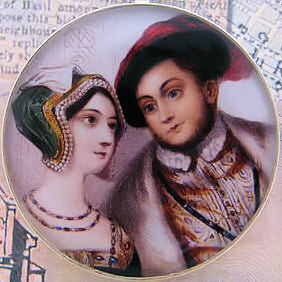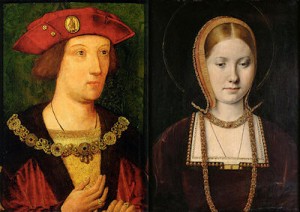 According to the chronicler Edward Hall, it was on this day in history, St Erkenwald’s Day 1532, that Henry VIII and Anne Boleyn secretly married:-
According to the chronicler Edward Hall, it was on this day in history, St Erkenwald’s Day 1532, that Henry VIII and Anne Boleyn secretly married:-
“The kyng, after his returne [from Calais] maried priuily[privily] the lady Anne Bulleyn on sainet Erkenwaldes daie, whiche mariage was kept so secrete, that very fewe knewe it, til she was greate with child, at Easter after.”1
As Hall says, the couple had just landed at Dover after a successful trip to Calais to meet Francis I, the French King, a trip on which Anne had played the part of Queen Consort to Henry. Hall is not the only person to give this date as their wedding date, Nicholas Sander, a Catholic recusant writing in Elizabeth I’s reign, also gave it as their wedding date in his book “The Rise of the English Schism”:-
“The king, now impatient of further delay, though everything had not yet been duly prepared, determined to marry Anne Boleyn secretly on the 14th of the following November. He must marry her, for in no other way could he accomplish his will; and the marriage must be secret, because he and Catherine had not been separated by any judicial decision.”2
Protestants latched onto this date as Henry and Anne’s wedding date, rather than the ceremony which we knew took place on the 25th January 1533, because it meant that Elizabeth I, was conceived in wedlock. Historian Eric Ives points out that the St Erkenwald’s date “does coincide with the approximate start of cohabitation” and “significantly, too, Nicholas Sander dates the marriage as 14 November although he had every reason to slander Elizabeth’s legitimacy”3. Ives goes on to say that the 14th November could well have been the date that Henry VIII and Anne Boleyn “made some sort of formal commitment”, although the proper wedding ceremony in January makes it unlikely that it was a formal marriage. Whatever the truth of the matter, something happened in Calais or on the couple’s return to make the couple confident enough to consummate their marriage and risk conception. I believe that the couple went through some kind of betrothal ceremony which then became binding on consummation.
14th November 1501
 On this day in history, 14th November 1501, Catherine of Aragon married Arthur, Prince of Wales at St Paul’s Cathedral. Giles Tremlett4, author of “Catherine of Aragon: Henry’s Spanish Queen”, writes of how a huge wooden stage, measuring twelve feet by 350 feet, had been erected in the cathedral. It stood on four foot struts and its railings were decorated with “say”, a fine wool or silk twill cloth. The stone walls of the cathedral were covered with tapestries and there was a red carpeted raised circular dais. It must have looked amazing.
On this day in history, 14th November 1501, Catherine of Aragon married Arthur, Prince of Wales at St Paul’s Cathedral. Giles Tremlett4, author of “Catherine of Aragon: Henry’s Spanish Queen”, writes of how a huge wooden stage, measuring twelve feet by 350 feet, had been erected in the cathedral. It stood on four foot struts and its railings were decorated with “say”, a fine wool or silk twill cloth. The stone walls of the cathedral were covered with tapestries and there was a red carpeted raised circular dais. It must have looked amazing.
Catherine, dressed in a white satin wedding dress was escorted from the Bishop’s Palace to the cathedral door by the ten year old Prince Henry, who would later become her second husband, and Lady Cecily of York carried her train. Catherine’s dress was Spanish in style with a farthingale and “many pleats” and her face was covered with a white silk veil decorated with a border of gold, pearls and gemstones. Her bridegroom, Prince Arthur, was also dressed in white satin.
Tremlett describes how the beginning of the wedding ceremony “was about politics and money”, with the marriage agreements being read out and Catherine’s dowry being announced. The bride was also given letters patent detailing her endowment and surety. After that, it was time for the religious part of the ceremony: the vows and mass. Catherine was then escorted out of the cathedral, to the sound of trumpets, by the young Henry while Arthur got himself ready to welcome her at the door of her chamber.
While the people of London enjoyed a pageant with a fountain running with wine, Catherine and Arthur enjoyed a sumptuous wedding banquet. Tremlett writes of how this was only the start of the celebrations and that the partying went on for a fortnight, consisting of jousts, masques and banquets.
After the feasting, it was, of course, time for the wedding night, the consummation of their marriage. The question of whether this marriage was ever actually consummated is still debated today. When Henry VIII was trying to annul his marriage to Catherine in the late 1520 and early 1530s, Catherine vowed that she had never slept with Arthur and this is backed up by evidence heard in Zaragoza, Spain, in 1531. There, Juan de Gamarra, who had been a boy in Catherine’s service at the time of her wedding, told of how the Prince had got up early the morning after and that when he, Gamarra, had entered Catherine’s rooms her ladies were concerned for Catherine and disappointed with the Prince. Gamarra stated:-
“Francisca de Cáceres, who was in charge of dressing and undressing the queen and whom she liked and confided in a lot, was looking sad and telling the other ladies that nothing had passed between Prince Arthur and his wife, which surprised everyone and made them laugh at him.”5
English witnesses, however, tell of Arthur demanding ale the next morning “for I have been this night in the midst of Spain!”
We just don’t know for sure what happened that night and during their short marriage.
So, a happy day for both Anne Boleyn and Catherine of Aragon today. Little did they know that their happiness would be short-lived. Ironically, before her wedding, Catherine of Aragon made an offering at the shrine of St Erkenwald, a tomb associated with miracles.
Notes and Sources
- Hall’s Chronicle, Edward Hall, p794 – parentheses are my own.
- Rise and Growth of the Anglican Schism, Nicholas Sander, p92-93
- The Life and Death of Anne Boleyn, Eric Ives, p170
- Catherine of Aragon: Henry’s Spanish Queen, Giles Tremlett,Chapter 10 “Wedding”
- Ibid.